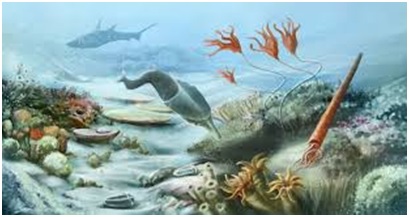This is the sixth part of The Ancients, a series of posts which, by this time, I’m pretty sure y’all know and love, so I’ll get straight to the point (Plus, I’m running out of adjectives). Check out parts 1-5 before this one!
Quick info:
Name : Silurian
Period: 443.8-419.2 m.y.a
Average Temperature: 17 Celsius
Atmospheric oxygen : 14%
So, as y’all already know, most of the major things were happening underwater. Life, more life, you know, pretty big stuff. Only real big thing that happened on the shore was, well, the creation of shores and the continents. So, it comes as a pretty big relief that something finally happened above the ocean. Two big islands, Laurentia and Baltica, crashed into each other, sending land everywhere. This helped the formation of modern North America. Another big thing was coral reefs. Now there were many species of coral reef that I didn’t cover when talking about the life of each period (‘Cause, honestly, what was I going to say? ‘This one is tube-shaped. How interesting!!’.) But during this period, they really started to multiply.

The most revolutionary thing that happened, however, was the creation and diversification of land plants. Let me repeat that. Land. Plants. This amazing creation allowed for the evolution of land animals as we know it, and it also changed the atmosphere irreversibly. The strange thing about this is that plants evolved significantly faster than animals. Puzzlingly so. By the end of the Silurian, they were small and simple, however, 46 million years later (small from an evolutionary standpoint), practically every form of modern plant was there, except flowering plants. (No flowers for now.) This rapid evolution and diversification was due to the challenges faced by land plants at the time. All plants have four basic needs : Getting sunlight, Exchanging gases, Conserving water, and Coping with external forces (GECC; but that’s not the official name.). If a plant had bigger leaves, it would get more sunlight, but would conserve less water. If the leaves shrunk, the exact opposite would occur. This evolutionary dilemma, plus radioactive UV rays from the sun, caused this rapid evolution.
During this eon, bony fish diversified, and land plants were limited to coastal areas, and the first land animals evolved. For example, Euryterus is an extinct genus of sea scorpion, which could breathe air, and walked on land for short periods of time. Pneumodemus, a type of giant millipede, was the first animal to truly walk on land and have a full lung system designed for breathing air and living on land, unlike the sea scorpion. As for land plants, Cooksonia were abundant in swamp and marsh biomes, and were still heavily aquatic, lacking roots. However, they were vascular, meaning their biological structure was similar to land plants today. Baragwanathia, was a genus of Lycopodiophyta, a division of still-living plants which evolved into most other plant divisions we know today. This genus in particular had small, simple leaves. Some bony fish were Acanthodii, fish which shared traits with both bony and cartilaginous fish, eventually evolving into modern day sharks. They were also one of the first fish to have jaws. Entelognathus was one of the first fish with thick, armored, plates. Its jaw also was closer to that of modern fish, being made up of several parts.
With the introduction of a new form of life, the world was edging ever closer to the world-famous reptiles. But, before that, fish had to evolve to live on land. And one of the animals I mentioned above was just the beginning of something as big as the dinosaurs.
Shaurya Prasad
Grade 7A